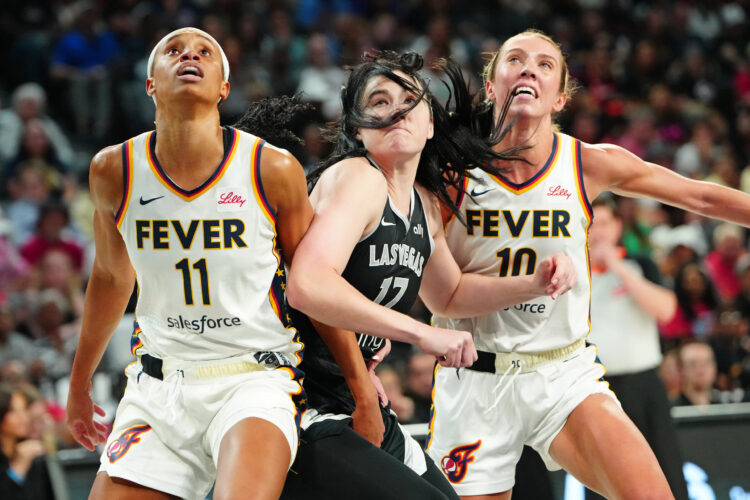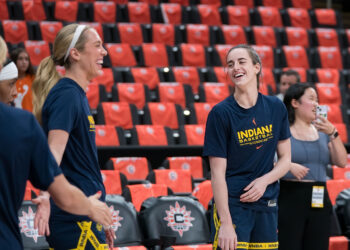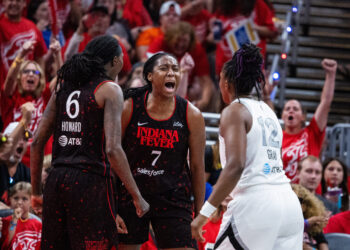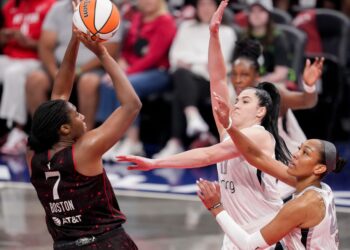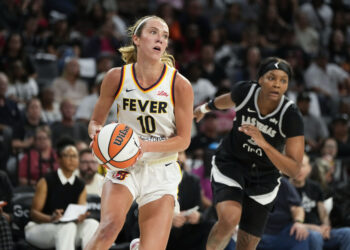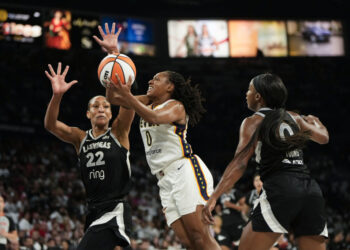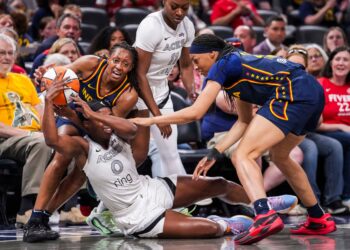The basketball told a story, one of a team that just didn’t quit. Resilience was the motto for Indiana all season long — even as they lost more talent in a pivotal Game 5 with a trip to the WNBA Finals on the line, others stepped up and kept battling. They fought back and tied the game, but the Aces stars were too much in the end. Yet during the 45-minute outing, the Fever kept huddling up. Almost every time, it was a different collection of players and coaches. Each one told a different, small tale about the Fever and their journey from a banged-up team near the lottery to a group on the doorstep of the WNBA Finals.
It started as it always does. Before taking the court for warmups, Fever players chanted “Go Fever!” before huddling up for about 10 seconds. They broke it down before heading onto the court. “1, 2, 3, together!” they all shouted in unison.
Togetherness has gotten the Fever far. Ask anyone about the team’s mentality and they’ll say either “we over me,” or “we all we got, we all we need”. It’s a group that keeps their heads high even when they aren’t playing; a squad that celebrates the successes of the group over the individual.
And it’s visible, too. The second noticeable huddle of the Fever’s performance showed it. Aerial Powers, a hardship player signed in August, has been in Indiana’s rotation throughout the playoffs, but her minutes have dropped almost every game. She gives Lexie Hull a short breather in every half, then sits the rest of the game. But Powers never moped about it. Instead, as the Aces called a timeout down at 11-9 with 4:26 to go in the first quarter, the veteran wing took on a leadership role. The Fever’s coaching staff was sharing notes before addressing the team, so Powers went up to each Fever starter one-by-one as they sat on the bench and gave them each a huge high five coupled with words of encouragement.
In the heat of battle, those moments are important. Support goes a long way, especially in a tight, pressure-filled game. “In our huddles, we kept talking about it — that we’re ready for these moments,” Fever head coach Stephanie White said postgame. After less than six minutes of game action, two Indiana Fever huddles had already shown how they were applying that readiness.
Want even more women’s sports in your inbox?
Subscribe now to The IX Sports and receive our daily women’s sports newsletter covering soccer, tennis, basketball, golf, hockey and gymnastics from our incredible team of writers. That includes Basketball Wednesday from founder and editor Howard Megdal.
Readers of The IX Basketball now save 50% on their subscription to The IX.
Every timeout for the rest of the first half was a similar scene. The collaboration between players never stopped. It was mostly encouragement, but occasionally one of the Fever’s many injured players would share tactical notes about what they were seeing in the game. Teamwork is a must for a group to reach its peak, and the Fever had it.
The collaboration extended to the coaching staff, too. They, too, would huddle up in timeouts before addressing the team. White, Briann January, Austin Kelly, and Karima Christmas-Kelly share duties well. And they had their own huddle that stood out during halftime.
Indiana trailed by two points at the break, and both squads stayed in the locker room for a while at halftime. With about three minutes left until the action would restart, several Aces players took the floor. Behind them was Becky Hammon, their head coach, followed by the Vegas assistants. Hammon went and sat alone for a few minutes with her clipboard on the bench, thinking about the upcoming stretch of play.
At the same exact moment on the opposite end of the court, the Fever’s coaching staff was huddled up together talking strategy. That’s not to say one way of coaching or the other is better — who knows what was going through Hammon’s mind in that moment, and she met up with her assistants soon after. But in a game, and a playoff run, where the Fever’s group-first focus took hold on the court, it was a telling scene in a tight game.
With 5:05 to go in the third quarter, the most significant huddle of the night occurred. Mitchell was down and clearly injured, and it happened suddenly. The Fever quickly formed a ring around the star guard with towels to keep her out of lines of sight while she lay on the hardwood in agony, and the shielding huddle was an important gesture. But it wasn’t the key one.
Instead, it came just a few moments later. As a stretcher came out for Mitchell, many players and coaches still surrounded her. They weren’t leaving her side. Mitchell then refused the stretcher with many Fever members still standing close by — White, Christmas-Kelly, Natasha Howard, Odyssey Sims, Hull, and Brianna Turner formed the side of the ring closest to the Fever bench.
The support of a fallen teammate is crucial. Mitchell eventually, with help, stood up. Fever staffers helped carry her off the floor, and she later went to the hospital after developing Rhabdomyolysis. Her body locked up, and her season ended right then.
Just before Mitchell was lowered to the floor, Boston committed her fifth foul of the night. It was a major moment — she had been critical for Indiana on both ends of the floor during the series, but she’d have to sit and watch for a few minutes.
Rather than being frustrated about her own deal, she was crushed about Mitchell. As Mitchell was carried off, Boston walked close by. Tears emerged on Boston’s face as they approached the tunnel. Mitchell was taken away, Boston went to the bench and chose a seat with nobody seated on either side of her. She needed a moment to herself.
For a possession or two, Boston dealt with a pile of emotions. Her foul, Mitchell’s injury, and a developing Aces run all happened essentially simultaneously. The All-Star center stared off into the distance. Then Hull hit a jumper, the Fever’s first points since the injury, and Boston snapped back into her world. She clapped and cheered for Hull, then did so again for Howard moments later. The Fever’s deficit was down to just four. They had a chance to win still, and Boston once again displayed their togetherness.
“I felt like I got kind of emotional seeing her down there. But for me, [I was] just trying to keep her calm, getting her slow breaths,” Boston said. “And once she walked off the court, it was time to just focus on rallying around her and making sure that I focused on when it was my time to go back in.”
Boston did end up fouling out with 27 seconds to go. That meant the Fever entered the overtime period down Mitchell, Boston, and Caitlin Clark — all three of their All-Stars. They did have possession of the ball with the score tied once in the extra period, but outside of that they were playing from behind the rest of the way. The Aces hit some tougher jumpers and pulled out a 107-98 win.
After the final buzzer, it was time for one more Fever huddle. The players, healthy and injured, got together on the court one last time and put their hands in the middle of the circle. Then, off they went. The season was over.
“Yeah, you know, it was sad. I think, especially when you push overtime and you fight for so long, your expectations are to win, obviously. So to lose is sad,” Hull said of the final huddle. “But I think arm in arm, all of us together, we can look at each other and be proud of each other. So it was a moment of love, for sure.”
That’s how the Indiana Fever pulled off this run, one that nearly went to the WNBA Finals — with love. They stuck together and reminded themselves of that before the game. They were well coached by a staff that had great synergy. They lifted each other and cried for each other. Even in defeat, they huddled.
In the end, they weren’t able to reach their goals. But the bonds forged this season still make the 2025 Fever an unforgettable team. Their togetherness was nearly enough to beat anyone.

“Becoming Caitlin Clark” is out now!
Howard Megdal’s newest book is here! “Becoming Caitlin Clark: The Unknown Origin Story of a Modern Basketball Superstar” captures both the historic nature of Clark’s rise and the critical context over the previous century that helped make it possible, including interviews with Clark, Lisa Bluder (who also wrote the foreword), C. Vivian Stringer, Jan Jensen, Molly Kazmer and many others.
